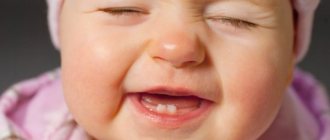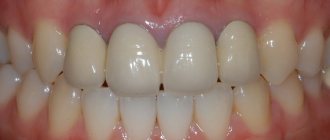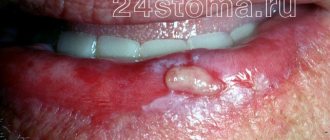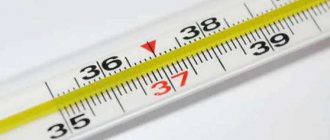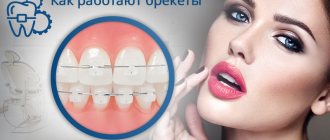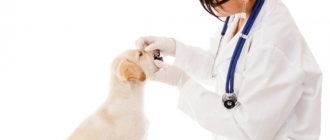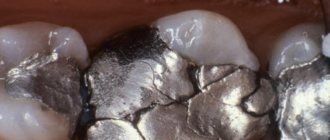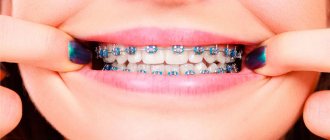The occurrence of malocclusion increases after three years of age, and among five-year-olds with a pacifier, crossbite occurs 22 times more often than among peers without this habit.
Concerned parents who are worried about the correct formation of their child’s bite come to our clinic. The cause of concern is most often the child's pacifier sucking habit. Can a pacifier really cause harm? How to prevent unwanted changes in the bite and at what age should you wean off the pacifier? In this article we answer the most frequently asked questions from parents.
What does a pacifier replace?
Already in the sixth month of intrauterine development, the fetus develops a sucking reflex. This fact is often observed by doctors and parents during ultrasound diagnostics: the child holds his finger in his mouth. The development of this skill will directly determine the baby’s survival after childbirth: how he can suck breast milk, how quickly he can adjust the mother’s lactation and, accordingly, will receive the nutrients vital for his existence.
However, this all concerns instincts provided by nature; in life, everything usually happens differently. For example, a mother deliberately or under pressure from circumstances refuses breastfeeding, switching to formula, or sharply reduces the frequency of breastfeeding. Everyone knows that there is no need to suck artificial nutrition out of the bottle, it pours out on its own. But the child’s powerful sucking reflex remains, he worries and cries, and this is where the pacifier comes to the parents’ aid.
In fact, it replaces the mother’s breast for the baby, and then for the older child, and not vice versa, as is commonly believed in our post-Soviet space. It is this imaginary convenience that often makes parents turn a blind eye to the problem of malocclusion from the pacifier. Therefore, if the mother provides the baby with breastfeeding on demand, and not according to a schedule, the pacifier simply will not be needed - his sucking reflex will be fully satisfied.
However, if for some reason difficulties arise with breastfeeding, a pacifier can also bring benefits:
- Breast replacement for formula-fed babies.
- Development of the sucking reflex in premature infants.
- Reducing anxiety and excitability in a child.
- Help with rocking a baby.
It is worth considering that among pediatricians and lactation consultants there is still no consensus on the use of a pacifier and its effect on the baby’s bite.
Measures to prevent malocclusion
Correcting malocclusion is much more difficult than preventing it. Parents need to know the following measures to prevent malocclusion:
- The expectant mother should protect herself from even the slightest cold.
- In the fifth month of pregnancy, the child begins the process of developing teeth, so calcium and fluoride must be present in the mother’s diet.
- Scrupulously follow your pediatrician's instructions regarding infant feeding, especially if breastfeeding is impossible.
- Make sure your child breathes through his nose. Otherwise, you need to consult a doctor to exclude the possibility of diseases of the respiratory system.
- In the early stages, the child should be weaned from thumb sucking and prolonged use of a pacifier.
- Approach with full responsibility the choice of an orthodontic pacifier and pacifier.
At what age does a child develop a bite?
Parents rarely think about when a child’s bite begins to form, yet this process occurs from birth and consists of several stages:
- From birth to six months. At this time, the jaws are preparing for the appearance of the first teeth and the correct placement of them during this period is very important.
- From six months to three years - the appearance of a temporary bite.
- From three to six years - preparation of the jaw for the appearance of permanent teeth, the temporary bite is fully formed.
- From six to twelve years, the baby teeth are replaced by permanent teeth, and during this period a mixed bite is formed.
- From twelve to fifteen years, a permanent bite is formed.
As you can see, it is very important to monitor the formation of a correct bite in a child from birth, and not from the appearance of permanent teeth, as many parents believe. Already at the stage of eruption of the first milk teeth, it is necessary to ensure that there is no constant pressure on the jaw, be it a finger in the mouth, a toy or a pacifier. After all, it is for this reason that a child develops an incorrect bite, including the pacifier.
What malocclusion pathologies may appear as a result of pacifier pressure on the jaw:
- Deep (the lower jaw extends far beyond the upper).
- Open (teeth from both jaws do not close together, forming a gap).
- Mesial (the lower jaw protrudes noticeably forward).
- Distal bite (with the jaws closed, the upper jaw moves forward in relation to the lower jaw).
- Crossed (weak development of one of the sides of the upper or lower jaw is observed).
In any case, the sooner the bite is determined, the easier it will be to correct the pathology in the future. If there are obvious problems already at primary school age, it is necessary to use special structures to correct the bite, such as plates, trainers, and at an older age - a brace system.
The optimal period for correcting the bite is adolescence, when the replacement of baby teeth with permanent ones has already occurred.
Causes of malocclusion in the first years of a child’s life
In addition to an incorrectly selected pacifier for a child, the main factors in the formation of malocclusion at an early age include:
- Genetic tendency in parents to malocclusion. The more relatives a child has with malocclusions, the more likely it is that he or she will develop pathology.
- Even in the womb, a baby can develop a defective bite: when the mother takes illegal medications, after suffering viral diseases (for example, chickenpox or rubella).
- Late appearance of baby teeth.
- The presence of such minor habits as sucking the lower lip or fingers, sticking out the tongue between the teeth. Even systematically gnawing on toys can lead to jaw deformation.
- After birth, malocclusion can be caused by incorrect feeding habits, especially with artificial formulas.
- Chronic diseases of the nose and larynx, as a result of which it is difficult for the baby to breathe through the nose.
- Problems with posture, as well as rickets at an early age, can cause malocclusion.
General harm from pacifiers
When parents think about whether the pacifier spoils the child’s bite, it turns out that there are some other negative aspects that this item can bring. Sucking on a pacifier for a long time can cause:
- Refusal to suck milk from the breast;
- Incorrect latching of the nipple during sucking, which can lead to breastfeeding pain for the mother.
- Speech delay, incorrect pronunciation of sounds and words.
- Allergic reaction.
- Delayed mental development of the child.
- Oral diseases.
- Mechanical damage in the mouth and chin area.
However, most pediatricians are of the opinion that using a pacifier for up to six months should not cause serious harm to the baby. After 6 months, the use of a pacifier is undesirable, and after a year it is necessary to reduce this habit in the child.
Negative action
Despite the benefits of using a pacifier to satisfy a baby's sucking reflex, most dentists are unanimous in the opinion that long-term use of it has a negative impact on the condition of the oral cavity.
The size of the lower jaw of a newborn is significantly smaller compared to the upper. To enhance its growth, experts recommend focusing on breastfeeding, during which the lower jaw moves forward and the tongue makes wave-like movements.
When using a pacifier, the natural muscular balance is disrupted, resulting from the pressure of the tongue on the jaw line and the contraction of the muscles of the cheeks and lips during sucking.
The nipple puts pressure on the periodontium, leading to excessive stress on the mucous membrane. As a result, emerging teeth may shift into incorrect positions.
Most often, children who abuse a pacifier are subsequently diagnosed with a distal or open bite, as well as excessive forward inclination of the teeth of the upper jaw.
Pathological changes in the structure of the dentition occur if the total duration of pacifier use exceeds 6 hours a day.
If a child uses a soothing object extremely rarely, it will not cause malocclusion.
Which is less harmful: a pacifier or a finger?
Doctors are unanimous on this issue: it is better to let the child suck a pacifier than his own finger. This is especially true for the period when baby teeth have not yet appeared. There are several reasons for this:
- The habit of thumb sucking is much stronger, because it is always there, you don’t have to ask or look for it like a pacifier.
- An infant who has a particularly strong need to satisfy the sucking reflex may seriously deform his finger.
- A pacifier made of high-quality materials and suitable for the baby’s age has much less negative impact on the jaws.
- The pacifier is easier to keep clean, it is disinfected, and you can be sure that the infection will not get into the child’s oral cavity in this way.
It is better to wean your baby off the habit of thumb sucking as early as possible, distracting him in every possible way with a pacifier or special latex teething toys.
How to choose a protective disk?
The disc serves as protection against swallowing of the nipple by the baby
Details to pay attention to when choosing a pacifier:
- Disk weight. It should not be heavy, otherwise the baby will not be able to hold the pacifier in his mouth.
- Product width. They are made according to the age of the baby. The older the child is, the wider the disc.
- How they are produced. Experts advise purchasing products with a solid cast disc. This will provide protection - the plate will not be able to break off and get into the mouth.
- Material. A number of developers use cheap raw materials and poor paints to paint the disc. The pacifier should be harmless so that nothing threatens the baby’s health.
- Ventilation holes. They must be present on the disk. If they are not there, then when sucking the nipple will fit tightly to the skin, and saliva will accumulate under the disc. This can lead to irritation.
Recommendations for using the pacifier
In order for the bite after the pacifier to form correctly and without pathologies, it is enough to comply with the following conditions:
- Do not allow your child to sleep with a pacifier in his mouth; this is easy to track: as soon as the baby is fast asleep, you need to carefully remove the pacifier from his mouth.
- Observe the rules of hygiene: wash pacifiers thoroughly after each use, boil if necessary or replace with new ones.
- Have several nipples; if one gets dirty, you will always have a clean one at hand.
- Buy special containers for storing pacifiers; they are sealed and protected from dirt and moisture.
- Try to give a pacifier only in extreme cases, and only when the child is not hungry.
- Monitor the condition of the pacifier; if there is the slightest crack or break, it must be replaced; if there are no defects, it is necessary to replace the pacifier with a new one every 1.5-2 months.
- Do not use a pacifier for the first time after discharge from the hospital, when the mother’s lactation is just establishing.
- Do not give your baby a pacifier for more than a total of 6 hours a day.
And the most important advice: do not give the pacifier at the first call of the child. You must first determine the cause of the baby’s restless behavior and try to calm him down by satisfying his natural needs - feeding him, rocking him in his arms, changing his diaper, etc. It is also worth noting that in addition to malocclusion, the nipple, if used frequently, can cause more significant harm - disrupt the psycho-emotional contact between mother and baby.
What is an orthodontic pacifier?
The main feature of this nipple is its shape - part of it is beveled and flattened, which corresponds to a more natural position in the child’s mouth. Why did they do this? According to these parameters, it corresponds to the anatomical shape of the mother's breast when feeding the baby. This is how you can achieve the most correct grip with your mouth, as well as the desired formation of your bite.
What is an orthodontic pacifier used for? Like any other pacifier, it is given to the child to calm him down, stop crying, and whims. But due to its shape, it also additionally stimulates the development of the jaw apparatus, strengthens joints and has a positive effect on the position of future teeth.
How to choose the right pacifier?
Modern parents are now seeing a huge range of pacifiers, from classic rubber ones to innovative latex ones with orthodontic properties. Which dummy will be correct and less harmful? Let's try to understand these subtle points and consider how nipples differ from each other:
- According to the material from which they are made. It is best if the nipple is made of silicone or latex. Silicone is more stable, withstands mechanical stress, but at the same time it deforms the baby’s jaws more strongly, unlike latex.
- To size. For each age of the child, a certain size of pacifier is provided; usually the manufacturer indicates this information on the packaging; compliance with this condition allows minimizing the harmful effects of the pacifier on the baby’s bite.
- According to the form. Nipples are classic and anatomical (orthodontic). Of course, experts recommend using the latter; they have less of a negative impact on the formation of the jaw apparatus.
- On the basis. It is better to choose pacifiers that have a recess on the base for the nose and chin, so they will not be damaged during active sucking.
Rating
The best pacifier for newborns is the Philips AVENT Classic silicone pacifier SCF182/13 0-6 m (2 pcs)
Advantages:
- Shape, nice design
- Without smell
- Material quality
Flaws:
- No
The best anatomical silicone nipple (pacifier) Canpol Babies Space Mission 18+ (1 piece)
Advantages:
- Materials quality
- Design
- Convenience
Flaws:
- Polluted from the inside
The best orthodontic pacifier (pacifier) silicone Chicco Physio Soft 12+ (1 piece)
Advantages:
- Quality of materials
- One-piece form
- Colors
- Lip shape
Flaws:
- Turns cloudy when boiled frequently
The best inexpensive (cheap) pacifier (pacifier) latex classic Snub-nosed Bow 0+ (1 piece)
Advantages:
- Appearance
- Availability of a protective cap
- Thoughtful mouthpiece
- Can be used by either side
Flaws:
- Form
- Fails quickly
The best pacifier (pacifier) from birth, silicone orthodontic Philips AVENT Ultra Soft SCF222/20 0-6 m (2 pcs.)
Advantages:
- No harmful substances
- Availability of a case
- The skin under the mouthpiece breathes
- Elasticity
Flaws:
- Water pours in when washing
The best nipple (pacifier) from 6 months, silicone anatomical Philips AVENT Classic SCF170/22 6-18 m (2 pcs)
Advantages:
- Form
- Soft silicone
- Appearance
- Protective cap
- Quality of materials
Flaws:
- Difficult to remove the cap
- Moisture sometimes gets inside
The best pacifier (pacifier) from the year, silicone orthodontic Chicco Physio Soft 12+ (1 piece)
Advantages:
- Quality of materials
- One-piece form
- Colors
- Mouthpiece shape
Flaws:
- Heavy
- No protective cap
The best pacifier (pacifier) for sleep, silicone anatomical Philips AVENT Night SCF176/18 0-6 m (2 pcs)
Advantages:
- Quality of materials
- Soft nipple
- Glows in the dark for easy searching
Flaws:
- The shape is not very comfortable
- Inconvenient shape of the mouthpiece
The best pacifier (pacifier) for premature babies, latex orthodontic NUK MedicPro 0+ (1 piece)
Advantages:
- German quality
- Light
- Convenience
- Use immediately after opening, without sterilization
Flaws:
- Smell
The best silicone pacifier (pacifier) orthodontic Chicco Physio Soft 0-6 m
Advantages:
- High quality material
- Softness
- Does not leave marks on the face
Flaws:
- Smell
The best latex pacifier (pacifier) classic Canpol Babies Animals Continents 6-18 m (1 piece)
Advantages:
- There is a protective cap
- Form
- Appearance
- Lightweight
- Quality of materials
Flaws:
- Water collects inside when boiling
The best rubber pacifier (pacifier) HEVEA Crown 3+m
Advantages:
- Natural
- Availability of ventilation
- Material quality
- Form
Flaws:
- Appearance
How to wean a child off a pacifier?
To avoid difficulties in weaning your baby off the pacifier, it is necessary to study the issue of child development more carefully. Until the age of 7 months, the child needs to satisfy the sucking reflex, which gradually changes to chewing by the age of one year. After all, from the age of 6 months, pediatricians recommend gradually introducing the first complementary foods. At this stage, it is easiest to wean a baby off a pacifier; after a year, this process will already become a bad habit, and not satisfy the sucking reflex.
In order not to create unnecessary stress for the child, the weaning process should be started slowly, gradually reducing the time the pacifier is used. At this stage, there should be no difficulties, because the child develops very quickly both mentally and physiologically, he is interested in everything new, and the research instinct is actively manifested. Therefore, parents can only look for ways to distract themselves from the pacifier, which should now be given only when the baby can no longer be calmed by anything. If you show patience and persistence at the moment, you can wean your baby off the pacifier very quickly and gently.
At the age of one and a half years, if the habit of sucking a pacifier still persists, parents must show the child to a pediatric dentist so that he can determine whether the pacifier can ruin the bite and how strong its effect on the jaw apparatus is.
If a child cannot do without a pacifier after two years, the help of a child psychologist may be needed, because, most likely, the baby is uncomfortable in the environment and the pacifier appears to him as a kind of reassurance and protection.
It is necessary to urgently wean your baby off the pacifier in special cases:
- If he has problems with hearing and speech.
- In cases of mental retardation (under the supervision of a specialist).
- Upon reaching the age of three years.
In any case, there is no universal way to wean off the pacifier; each baby needs a different approach. However, general recommendations boil down to the fact that during this difficult period for the child, you need to provide him with maximum comfort and protection, as well as distract him in every possible way and allow him to develop naturally.
Popular brands of pacifiers (pacifiers)
- MAM - from Austria with care and love for children! The MAM baby products brand has been working for over 40 years to create pacifiers, bottles and teethers that appeal to even the most capricious babies and make life easier for their parents. Today, MAM has many years of experience working with experts in the field of pediatric medicine, dentistry and developmental psychology. Together with them, the brand was able to develop innovative shapes, details and materials that make the products as comfortable to use as possible for the child and promote proper development at all stages of a newborn’s life.
- P hilips AVENT is a leading company in the production of children's products. Pacifiers are distinguished by high quality, reliability, and bright design.
- Сhicco – Italian quality, recognized throughout the world. Pacifiers are designed taking into account all the physiological characteristics of the baby to ensure maximum safety.
- Nuk is a German brand. Production is located directly in Germany under the careful supervision of European specialists. The products are safe and environmentally friendly.
- HEVEA – modern teethers and pacifiers made of natural rubber. The brand's products are safe, hygienic, environmentally friendly, and have an interesting design.
- Bibi is a Swiss brand that has been around for over 75 years. Products are developed together with the best experts and specialists.
- Canpol Babies. For more than 25 years you can find products from this brand. The quality of the products is confirmed by numerous awards, prizes, and nominations. This brand constantly participates in various competitions, exhibitions and receives well-deserved awards. High quality standards and innovative technologies are the features of this brand.
- Pigeon is a Japanese manufacturer whose products already account for more than 70% of the market in Japan. The brand's pacifiers can be found in European countries and around the world.
- Brown. Another world-famous manufacturer of children's products. All pacifiers are thought out to the smallest detail so that the child feels comfortable and the parents feel calm.
- Tigex is a French brand. It has been introduced to the domestic market relatively recently. Only high-quality and safe materials are used in production.
Child oral care
You can soften the effect of the pacifier on the baby's palate and jaws not only by using anatomical models, but also by using special oral care products. ASEPTA Baby products are rightfully considered one of the best children's dental products:
- ASEPTA Baby wet wipes from 0 to 3 years (special finger pads are designed for gentle cleansing and massage of the baby’s oral cavity).
- ASEPTA Baby gel toothpaste from 0 to 3 years (effective prevention of inflammatory processes in the oral cavity and prevention of the development of caries in children).
- ASEPTA Kids gel toothpaste from 4 to 8 years (prevention of caries, inflammatory processes and tartar formation).
- Paste for permanent teeth ASEPTA Teens from 8 years (saturation of tooth enamel with minerals, prevention of caries and prevention of gum inflammation).
Thanks to the wide range of tastes and aromas of ASEPTA products, the child will be happy to brush his teeth on his own. The natural composition of the pastes, as well as beneficial plant extracts and calcium enrichment, makes the series an indispensable oral care product for children. ASEPTA cares about the health of children's teeth!
Sources:
- Study of the clinical effectiveness of the use of therapeutic and prophylactic agents of the ASEPTA series in the treatment of inflammatory periodontal diseases in children and adolescents (I.V. Klimova) Irina Vladimirovna Klimova, Candidate of Medical Sciences, Associate Professor of the Department of Pediatric Dentistry, Novosibirsk State Medical University. Department of Pediatric Dentistry, Novosibirsk State Medical University.
- The use of adhesive balm "Asepta®" in the treatment of inflammatory periodontal diseases L.Yu. OREKHOVA*, Dr. med. Sciences, Professor, Head of Department V.V. CHPP**, Dr. med. Sciences, Professor, Head of Department S.B. ULITOVSKY*, Dr. med. Sciences, Professor A.A. LEONTIEV*, dentist A.A. DOMORAD**, O.M. YAKOVLEV** SPbSMU named after. acad. I.P. Pavlova, St. Petersburg - *Department of Therapeutic Dentistry, **Department of Microbiology
- Clinical experience in using the Asepta series of products Fuchs Elena Ivanovna Assistant of the Department of Therapeutic and Pediatric Dentistry State Budgetary Educational Institution of Higher Professional Education Ryazan State Medical University named after Academician I.P. Pavlova of the Ministry of Health and Social Development of the Russian Federation (GBOU VPO RyazSMU Ministry of Health and Social Development of Russia)
Selection rules
To reduce the harm caused to the baby by regular use of a pacifier, it is necessary to choose this device correctly.
Preference should be given to special orthodontic nipples. These products differ from ordinary pacifiers in their anatomical shape, which is equipped with a beveled surface on one side and a convex surface on the other.
In this case, the beveled part of the product must be placed on the side of the child’s tongue, and the convex part in the area of the palate.
Thanks to this design of the pacifier, the growth of the lower jaw is activated, which from the birth of the child significantly lags behind the upper jaw in size.
In addition, the pressure exerted on the palate and upper jaw is insignificant, which contributes to their full development.
When choosing, you must also pay attention to the following points:
- Material of manufacture. There are two types of nipples on sale: silicone and latex. Silicone products are more durable and can withstand high temperatures, making them easier to boil.
At the same time, they have little elasticity, so after teething, there is a possibility that the child will chew them.Pacifiers made from latex are more durable, however, they cannot withstand high temperatures and also quickly accumulate bacteria on the surface, so they will have to be changed more often. In addition, latex products can cause an allergic reaction.
- Size. Depending on the age of the child, the size of the pacifier changes. So, for babies up to 6 months, a size 1 pacifier is suitable. Children older than six months should use size 2.
- The presence of an air valve. This indicator is important when choosing a bottle nipple for feeding. The presence of a valve reduces the likelihood of the baby swallowing air, as well as the pacifier sticking together.
Methods of treating crowded teeth and the consequences of lack of therapy.
In this article we will discuss the problem of a small lower jaw in an adult.
Follow the link https://orto-info.ru/zubocheliustnye-anomalii/ryadov/zuboalveolyarnogo-ukorocheniya.html to learn more about dentoalveolar shortening in the molar area.
Consumer Reviews
User about ASEPTA TEENS toothpaste Vasilisa (eapteka.ru)
“Asepta Baby wet wipes were very helpful in my time. When my daughter’s teeth began to erupt wildly, one by one, I began to try many children’s pain relievers that I knew. They helped for a maximum of 10 minutes and then the daughter’s terrible “screams” began again. Then I just started going to every pharmacy and asking for the best, most effective product, no matter what the price. And one of the pharmacists suggested these napkins to me; they were even cheaper than the products I had bought before, around 250 rubles. When I read about them on the Internet, I learned that wipes not only help relieve and relieve pain from teething, but also instill daily hygiene habits and disinfect the oral cavity in general. According to the instructions, I wiped my daughter’s entire oral cavity, her gums, her cheeks, her tongue, everything. With these napkins, my daughter became much calmer; of course, I noticed that my daughter was experiencing discomfort in her mouth, but not that much. Now I often take them on the road for myself and my children, when I can’t brush my teeth; for me, this is another plus for these napkins).”
Vasilisa about ASEPTA BABY napkins (market.yandex.ru)
“My teenage son brushes his teeth with this paste. His teeth and gums are very sensitive, so the dentist recommended this paste from Asepta, because... it is low-abrasion, for gentle care. Its appearance is cool, we like it - such an interesting animal is depicted. The paste foams well. It has the taste and aroma of either peach or apricot; sometimes I really want to change my boring mint paste to my son’s. The texture is gel-like, but not transparent - it is used sparingly.”
The best classic pacifiers
HEVEA Crown 0–3 m (1 piece)
HEVEA Crown is one of the best nipples, which tops many ratings based on reviews from mothers. Designed for children from birth, has a round nipple shape. Its special feature is its one-piece construction. There are no seams or cracks that could injure the baby's skin. Thanks to the one-piece design, the product is very difficult to break. In addition, the absence of seams ensures better hygiene.
The holes on the mouthpiece promote air ventilation between the plastic base and the skin. The slots on the shield are made in the form of small crowns. This design is suitable for both girls and boys.
The pacifier is made from 100% ecological raw materials – natural rubber. It does not contain unsafe ingredients such as BPA, PVC, artificial colors and phthalates. Rubber copes well with its function: wear-resistant, withstands the action of not only the palate and tongue, but also teething teeth. The soft, safe hygienic material can be given to newborns without fear. Even for product packaging, environmentally friendly, biodegradable materials are used.
Pros:
- 100% pure, harmless latex;
- soft rubbery texture;
- seamless, molded construction;
- ventilation slots in the original design;
- increased hygiene of the product.
Minuses: -
Munchkin Latch 0+ (2 pcs)
Developed in collaboration with pediatric dentists and mothers. It has minimal weight, so even babies from birth can easily hold it in their mouth. The pacifier is made from a single piece of soft silicone. This feature ensures comfort and safety while sleeping. There is no plastic in the design at all, which significantly reduces the risk of irritation. The natural round shape is familiar to the newborn, so it will not cause discomfort. The shield is made in the shape of a heart, its contour goes around the spout and ensures the unhindered passage of air. The set comes with 2 nipples, which makes the purchase more profitable.
Pros:
- one-piece shape without seams;
- no plastic in composition;
- can be used from birth;
- the shape of the shield with a recess that goes around the spout;
- does not contain bisphenol A (0% BPA);
- inexpensive price;
- a light weight.
Minuses:
There is no cover to protect it from contamination.
Brown's HappyPaci 0–6 months (2 pcs.)
Pacifier from the American brand Dr. Brown's is outwardly laconic and simple. The shape completely duplicates the nipple of the bottle. Dr. Brown's HappyPaci is made from medical grade silicone. It is durable enough to withstand long-term use.
The structure is solid, cast, which allows you to better maintain the cleanliness and sterility of the children's accessory. In addition, the absence of small parts that can fall off at any time improves safety performance. The design does not include a ring holder. The mouthpiece is made in the shape of a butterfly and has an ergonomic shape.
The product is well sterilized without losing its shape. Designed to take into account the natural development of children's teeth and gums.
Pros:
- increased security;
- a shape that is well accepted by the baby;
- 2 pieces per pack;
- cast structure without unnecessary parts;
- holes for air to enter under the mouthpiece;
- easy operation;
- easy care.
Minuses:
There is no recess for lips in the mouthpiece. For this reason, it may often fall out of the mouth.
Surgical treatment of inverted nipples
The surgical procedure depends on whether the patient plans to become pregnant in the future. If pregnancy is planned, the surgeon preserves the integrity of the milk ducts; if not, he dissects them. There is no big difference in the final results, but you should be aware that the preservation of the milk ducts can cause repeated nipple retraction (although the risk is still very small).
Regardless of whether the milk ducts are dissected, the operation can be performed either under local anesthesia or general anesthesia. To achieve better results and high aesthetics, the work is performed under a microscope.
Progress of the operation with preservation of the milk ducts:
- Anesthesia.
- Making incisions several mm long extending from the nipple.
- Release of the nipple and prolongation of the milk ducts.
- Creation of a triangular skin flap.
- Nipple pulling.
- Stitching.
The operation to correct the nipple while preserving the milk ducts lasts about 40 minutes.
Plastic surgery of inverted nipples with dissection of the milk ducts has a slightly different procedure:
- Anesthesia.
- Nipple incision.
- Dissection of the milk ducts.
- Stopping the bleeding.
- Applying internal sutures.
- Applying external sutures.
This operation lasts about an hour.
Postoperative period: what to expect and how to behave?
After the operation, bruising and swelling of the chest may be observed, which disappear without a trace within a couple of weeks. Thanks to small incisions and work under a microscope, the sutures heal quickly and there are practically no traces left of them.
For some time after surgery, a woman may notice a decrease in the sensitivity of the areolas and nipples, but within a few weeks the sensitivity returns.
The postoperative period requires avoiding visiting the solarium and sauna. If possible, you should avoid physical activity and stressful situations. In addition, it is recommended to walk more and breathe fresh air.
It is worth noting that prevention obliges the patient to visit a specialist at least once every six months, even if the operation is successful.
